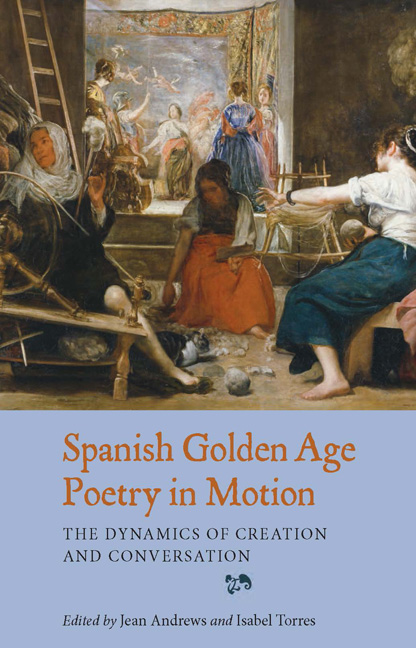Book contents
- Frontmatter
- Contents
- Contributors
- Acknowledgements
- Introduction
- 1 La poesía mutante del Siglo de Oro
- Part 1 Poetry in Creation
- 2 Moving in …Garcilaso de la Vega's ‘Dulces prendas por mi mal halladas’
- 3 The Movement of Thought and Feeling in the ‘Ode to Juan de Grial’
- 4 Metaphors of Movement in Two Poems of Fray Luis de León
- 5 El tiempo medido en versos: Camila Lucinda en las Rimas (1609) de Lope de Vega
- 6 Upwards to Helicon: Lope de Vega, the Laurel de Apolo, and Acts of Judgement
- 7 ‘Dulce es refugio’: El peregrino de Góngora se detiene
- 8 The Staging of Góngora's Three Funereal Sonnets for Margarita de Austria Estiria
- 9 Jealousy in María de Zayas's Intercalated Poetry: Lyric Illness and Narrative Cure
- 10 Hacia otra lectura del petrarquismo en Sor Juana Inés de la Cruz
- Part 2 Poetry in Conversation
- 11 El conde de Salinas y Leonor Pimentel: cuando se juntan el amor y la poesía
- 12 Poesía popular en movimiento: los jeroglíficos ‘muy propios al intento y muy de su profesión’ en las celebraciones de la Valencia barroca
- 13 Responding to Góngora: María Rosal and the Clori Poems
- 14 Traveling in Place: Baroque Lyric Transports in Translation, or Flames that Bridge the Stream
- Works Cited
- Index
6 - Upwards to Helicon: Lope de Vega, the Laurel de Apolo, and Acts of Judgement
Published online by Cambridge University Press: 05 November 2014
- Frontmatter
- Contents
- Contributors
- Acknowledgements
- Introduction
- 1 La poesía mutante del Siglo de Oro
- Part 1 Poetry in Creation
- 2 Moving in …Garcilaso de la Vega's ‘Dulces prendas por mi mal halladas’
- 3 The Movement of Thought and Feeling in the ‘Ode to Juan de Grial’
- 4 Metaphors of Movement in Two Poems of Fray Luis de León
- 5 El tiempo medido en versos: Camila Lucinda en las Rimas (1609) de Lope de Vega
- 6 Upwards to Helicon: Lope de Vega, the Laurel de Apolo, and Acts of Judgement
- 7 ‘Dulce es refugio’: El peregrino de Góngora se detiene
- 8 The Staging of Góngora's Three Funereal Sonnets for Margarita de Austria Estiria
- 9 Jealousy in María de Zayas's Intercalated Poetry: Lyric Illness and Narrative Cure
- 10 Hacia otra lectura del petrarquismo en Sor Juana Inés de la Cruz
- Part 2 Poetry in Conversation
- 11 El conde de Salinas y Leonor Pimentel: cuando se juntan el amor y la poesía
- 12 Poesía popular en movimiento: los jeroglíficos ‘muy propios al intento y muy de su profesión’ en las celebraciones de la Valencia barroca
- 13 Responding to Góngora: María Rosal and the Clori Poems
- 14 Traveling in Place: Baroque Lyric Transports in Translation, or Flames that Bridge the Stream
- Works Cited
- Index
Summary
One of Lope de Vega's (1562-1635) longest poetic works, the Laurel de Apolo (1630), has received less critical attention than much of his other poetry due to its sheer length. This massive poem, composed of ten silvas and totalling nearly seven thousand lines, is sometimes viewed as a simple litany of praise for several hundred contemporary poets. However, one often overlooked element is the way in which Lope uses this text to engage in acts of judgement and even personal vendettas against his rivals. The purpose of this study is to examine how Lope moves his locus of enunciation to a mythological space (Mount Helicon) and also shifts the poem's narrative voice to various subjects in order to pass judgements that are as personal and ethical as they are aesthetic. The concept of movement in this regard is thus essential to arrive at a more thorough understanding of the Laurel and these less-examined nuances.
An exhaustive analysis of the Laurel and each of its ten silvas would be impossible for the length of this study. Instead, this study will focus in part on Lope's use of a mythological location to highlight his interpersonal rivalry with one poetic figure of the day, Jusepe de Pellicer. Pellicer was a noted Gongorist who had attacked Lope in his poem El Fénix (published earlier in the same year as the Laurel, 1630, though written and publicly known to Lope prior to the Laurel), as well as in his Lecciones solemnes a las Obras de don Luis de Góngora.
- Type
- Chapter
- Information
- Spanish Golden Age Poetry in MotionThe Dynamics of Creation and Conversation, pp. 101 - 116Publisher: Boydell & BrewerPrint publication year: 2014



